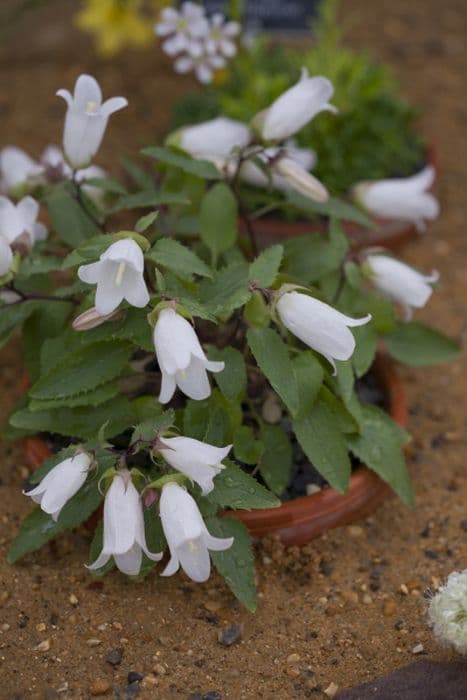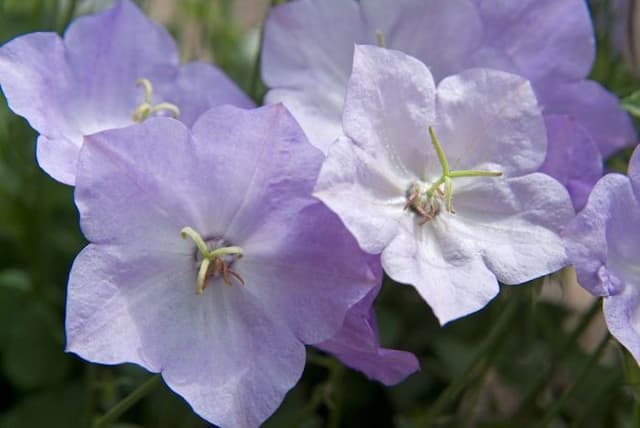Edging Lobelia Lobelia erinus 'String of Pearls'

ABOUT
Lobelia erinus 'String of Pearls' presents a unique and delicate appearance, characterized by its cascading nature that resembles a string of tiny, spherical pearls. The plant features an abundance of small, intensely colored flowers which are often a striking blue or violet hue. Each flower showcases a dainty two-lipped shape, with the upper lip having two lobes and the lower lip three. The foliage of 'String of Pearls' is made up of small, narrow leaves that are typically green in color, providing a lush background that accentuates the vibrant colors of the blossoms. The leaves are closely spaced along the stems, creating a dense, full look that adds to the overall texture of the plant. The stems themselves are thin and trailing, tending to spill gracefully over the edges of containers or hanging baskets. This growth habit makes the plant especially popular for vertical gardening elements, where it can be displayed to full effect. Although compact in form, the plant branches nicely, which contributes to its fullness and enhances its suitability for small spaces or as part of more extensive floral arrangements. The overall impression of 'String of Pearls' is one of a dainty and intricate plant that offers a burst of color and a soft, trailing structure that can soften and enliven any garden space or indoor setting.
About this plant
 Names
NamesFamily
Campanulaceae.
Synonyms
Trailing Lobelia, Garden Lobelia, Edging Lobelia, Cascade Lobelia.
Common names
Lobelia erinus 'String of Pearls'.
 Toxicity
ToxicityTo humans
Lobelia is generally considered to have a low level of toxicity to humans. However, if ingested in significant amounts, it can cause symptoms such as nausea, vomiting, diarrhea, cough, dizziness, excessive salivation, and weakness. In severe cases, consumption may lead to more serious symptoms like heart problems, convulsions, or even coma. It is advisable to avoid ingesting this plant and to keep it out of reach of children who might be tempted to eat it.
To pets
Lobelia is also known to be toxic to pets, including domestic animals like cats and dogs. If pets ingest any part of the plant, they could experience symptoms similar to those in humans - nausea, vomiting, diarrhea, excessive salivation, difficulty breathing, and signs of general distress. In severe cases, ingestion could lead to more critical conditions like a drop in blood pressure, tremors, or cardiac abnormalities. Pet owners should be cautious and prevent their pets from accessing this plant.
 Characteristics
CharacteristicsLife cycle
Annuals
Foliage type
Evergreen
Color of leaves
Green
Flower color
Blue
Height
6 inches (15 cm)
Spread
24 inches (61 cm)
Plant type
Herb
Hardiness zones
10
Native area
South Africa
Benefits
 General Benefits
General Benefits- Enhances Garden Aesthetics: The vibrant blue, violet, or white flowers of Lobelia erinus, commonly known as edging lobelia, add visual appeal and a splash of color to garden beds and borders.
- Low Maintenance: Edging lobelia is an easy-to-care-for plant that requires minimal upkeep once established, making it an excellent choice for both novice and experienced gardeners.
- Attracts Pollinators: The colorful flowers attract bees, butterflies, and other pollinating insects, helping to support the local ecosystem.
- Excellent for Containers: Due to its compact size and cascading habit, edging lobelia is an ideal choice for hanging baskets, window boxes, and other container gardens.
- Long Blooming Period: Edging lobelia typically blooms for an extended period, often from late spring into fall, providing long-lasting garden interest.
- Versatile Garden Use: This plant can be used in a variety of garden settings, including rock gardens, borders, and as a groundcover, thanks to its trailing and mounding growth habits.
- Drought Tolerant: Once established, edging lobelia exhibits some drought tolerance, reducing the need for frequent watering.
- Seasonal Interest: In regions with mild climates, edging lobelia may act as a perennial, contributing to the year-round interest in the garden.
- Cold Resistant: The plant has some frost resistance, which can be an advantage in cooler climates or unexpected cold snaps.
 Medical Properties
Medical PropertiesThis plant is not used for medical purposes.
 Air-purifying Qualities
Air-purifying QualitiesThis plant is not specifically known for air purifying qualities.
 Other Uses
Other Uses- Lobelia as a natural dye: The flowers of Lobelia can be used to produce a blue or violet dye for textiles.
- Photography prop: With its delicate appearance, Lobelia makes an excellent subject for macro photography and botanical art.
- Fairy gardens: Given its small size and cascading habit, Lobelia is often incorporated into miniature fairy garden designs.
- Educational tool: Lobelia can be used in schools or educational programs to teach children about plant growth and care.
- Garden border definition: Planting a row of Lobelia can create a visually appealing border that outlines garden paths or sections.
- Living mulch: Lobelia can serve as a living mulch, covering soil in garden beds and thereby reducing weed growth and soil erosion.
- Artistic inspiration: Artists may use the intricate structure of Lobelia blooms as inspiration for various forms of artwork, such as paintings or sculptures.
- Decorative garnishes: The flowers of Lobelia could potentially be used as non-toxic decorative garnishes on plates and in drinks for special events, although they are not typically consumed.
- Pet companion planting: Non-toxic varieties of Lobelia can be planted in pet-friendly gardens as a safe ornamental plant around pets.
- Seasonal crafts: Lobelia's flowers and foliage can be incorporated into seasonal crafts, such as wreaths or table centerpieces during the spring and summer months.
Interesting Facts
 Feng Shui
Feng ShuiThe Lobelia is not used in Feng Shui practice.
 Zodiac Sign Compitability
Zodiac Sign CompitabilityThe Lobelia is not used in astrology practice.
 Plant Symbolism
Plant Symbolism- Devotion: Lobelia, often associated with feelings of affection and loyalty, could represent strong devotion between individuals, whether in a romantic or platonic context.
- Protection: The plant is sometimes used as a symbol to ward off negativity or evil spirits, indicating a form of spiritual or emotional safeguarding.
- Communication: Given its delicate structure and graceful appearance, lobelia may symbolize the need for clear and considerate communication in relationships.
- Healing: Due to some varieties of lobelia being used in herbal medicine, it can symbolize healing and recovery from illness or hardship.
- Uniqueness: The 'String of Pearls' variety, with its distinctive cascading pearls-like shape, may symbolize uniqueness and the beauty of standing out from the crowd.
 Water
WaterEdging lobelia should be watered regularly to keep the soil consistently moist but not waterlogged. You should water this plant thoroughly when the top inch of soil feels dry to the touch, which may be approximately once a week, depending on the climate and weather conditions. In hotter periods it may require more frequent watering, such as every other day. Generally, use about a gallon of water per plant for each watering session, ensuring the water is reaching the roots and not just wetting the surface.
 Light
LightEdging lobelia thrives best in full sun to partial shade. Ideally, plant your lobelia where it can receive at least 4 to 6 hours of sunlight per day. Morning sun with afternoon shade is optimal to protect it from the midday heat, especially in regions with very hot summers.
 Temperature
TemperatureEdging lobelia grows best in conditions that stay between 55 and 70 degrees Fahrenheit. It can tolerate temperatures down to about 40 degrees Fahrenheit but will suffer if it gets colder. Similarly, it does not perform well in high heat and should be protected from temperatures exceeding 80 degrees Fahrenheit for prolonged periods.
 Pruning
PruningPrune edging lobelia to encourage bushier growth and prolong its blooming period. Lightly pinch back the tips of the stems during the growing season, especially after a flush of blooms, to promote more flowers. Pruning is best done in the morning or evening and can be performed every few weeks to maintain the desired shape.
 Cleaning
CleaningAs needed
 Soil
SoilLobelia, commonly known as edging lobelia or garden lobelia, thrives in well-draining soil that is rich in organic matter with a pH range of 6.0 to 7.5. A mixture of peat, perlite, and compost is ideal, ensuring sufficient drainage while retaining moisture.
 Repotting
RepottingGarden lobelia should be repotted every 1-2 years to replenish nutrients and prevent overcrowding. Younger plants may benefit from more frequent repotting, while established lobelias can be repotted less often.
 Humidity & Misting
Humidity & MistingGarden lobelia prefers moderate to high humidity levels but can adapt to normal household humidity. It is important to avoid overly dry air, which can lead to stress and leaf drop.
 Suitable locations
Suitable locationsIndoor
Place garden lobelia in bright, indirect light and keep soil lightly moist.
Outdoor
Plant garden lobelia in partial shade; water regularly to maintain moist soil.
Hardiness zone
10-11 USDA
 Life cycle
Life cycleLobelia erinus 'String of Pearls' starts its life cycle as a seed, typically sown in late winter to early spring. Upon germination, seedlings establish themselves and begin to form a low, bushy mound of foliage. As the plant matures, numerous small, rounded leaves grow along thin stems, displaying the characteristic "String of Pearls" appearance. Throughout the summer, the plant produces a profusion of small, colorful flowers, often in shades of blue, violet, or white. After flowering, the plant sets seed, which can be collected for propagation or allowed to self-sow. During the fall and into winter, Lobelia erinus 'String of Pearls' may die back, especially in colder climates, completing its annual life cycle, unless grown as a perennial in warmer zones.
 Propogation
PropogationPropogation time
Spring-Early Summer
Propogation: Lobelia, specifically Lobelia erinus 'String of Pearls', is most commonly propagated through seed. The optimal time for sowing Lobelia seeds is in late winter to early spring, which allows for the establishment of seedlings that can be transplanted after the last frost. To propagate Lobelia from seed, start by scattering the tiny seeds over the surface of a well-draining, seed-starting mix. Because the seeds need light to germinate, they should not be covered with soil but can be gently pressed into the surface. The seed tray or container should be kept moist and in a warm, bright environment but out of direct sunlight. Germination typically takes 14 to 21 days. Once seedlings develop their first set of true leaves and are large enough to handle, they can be transplanted into individual pots or spaced appropriately in the garden.









